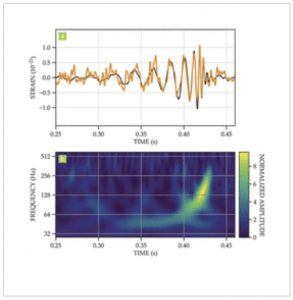Daniel Holz, Scott Hughes, and Bernard Schutz in Physics Today:

Decades of experimental effort paid off spectacularly on 14 September 2015, when the two detectors of the Laser Interferometer Gravitational-Wave Observatory (LIGO) spotted the gravitational waves generated by a pair of coalescing black holes.1 To get a sense of the effort leading to that breakthrough, consider that the gravitational waves caused the mirrors at the ends of each interferometer’s 4 km arms to oscillate with an amplitude of about 10−18 m, roughly a factor of a thousand smaller than the classical proton radius. The detection was also a triumph for theory. The frequency and amplitude evolution of the measured waves precisely matched general relativity’s predictions for the signal produced by a binary black hole merger, even though the system’s gravity was orders of magnitude stronger than that of any system that had been precisely probed before that detection. As figure 1 shows, gravitational-wave astronomy began not with a bang but with a chirp.
More here. [Thanks to Sean Carroll.]
